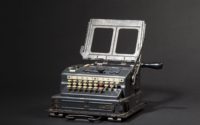 An extremely rare German cryptographic machine in excellent condition has sold at auction for €98,000 ($110,000). The Schlüsselgerät (meaning “cipher machine”) 41 was supposed to replace the famous Enigma enciphering machine after it was cracked by Alan Turing and the Bletchley Park codebreakers in 1941, but very few ended up being produced and only a handful of survived in working condition. They’re so rare that even corroded husks are still prized by museums. This one is not only functional, it looks practically new.
An extremely rare German cryptographic machine in excellent condition has sold at auction for €98,000 ($110,000). The Schlüsselgerät (meaning “cipher machine”) 41 was supposed to replace the famous Enigma enciphering machine after it was cracked by Alan Turing and the Bletchley Park codebreakers in 1941, but very few ended up being produced and only a handful of survived in working condition. They’re so rare that even corroded husks are still prized by museums. This one is not only functional, it looks practically new.
The SG-41 was invented by cryptologist Fritz Menzer. Menzer had enlisted in the Reichswehr as a mechanic when he was 18 years old and without any formal training, developed an interest in cryptography into inventing new cracking methods and devices. In 1940, he was appointed Regierungs-Oberinspektor of the OKW/Chi, the cryptology division of the German Army High Command.
The new device had six wheels (Enigma had three, four in later models) that could rotate in both directions and used two reels of paper, one for the original text, the other for coded message, rather than bulbs illuminating letters. The keyboard operation made it much faster to use and the encryption algorithms were more complex and sophisticated. The hand crack on the side inspired the machine’s nickname: Hitlermühle, or Hitler Mill.
Even though it was distinctly superior to the Enigma machines in cryptographic functionality, the SG-41 wasn’t used until 1944. The problem was the hardware. They were supposed to lightweight and durable for use on the front lines, but shortages of aluminum and magnesium forced the use of heavier materials. The end-result was a machine that weighed 25-33 pounds which made them much too heavy for field use.
Three years after their invention, a few SG-41s made it into production. About 500 were made by Wanderer-Werke in Chemnitz, eastern Germany (makers of the iconic Continental typewriters), and dispatched to the Abwehr in late 1944 to replace the limping and inadequate Enigma-G machines still in use. Another thousand (the SG-41Z variant), were sent to the Luftwaffe weather service. The Wehrmacht planned to manufacture 1,000 of them by October 1945 and ramp up production to 10,000 a month by January of 1946. The war ended first.
The recently-sold example is one of the Abwehr machines, so one of only 500 ever made. The auctioneers enlisted cypher machine expert Klaus Kopacz to examine their Hitler Mill. They disassembled it, adjusted the wheels, inserted paper reels and tested it. Everything worked. All it needs is some WD-40 and fresh ink as the printouts were barely legible. There are only five small parts missing (a button, a spacer, a spring, a bolt and a metal disc), all easily replaceable.